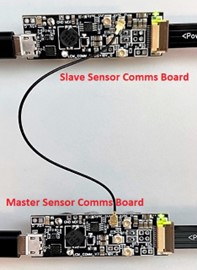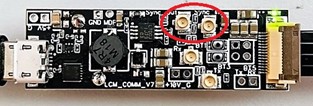Introduction:
The QTFM2 operates using magnetic field-producing coils within the sensor head to polarize the vapor between measurements. When deploying multiple sensors simultaneously, their respective fields can interfere with each other. However, the QTFM2 is designed to sync the clocks of multiple sensors, ensuring all coils are inactive during measurements, thus eliminating interference.
Step-by-Step Guide for Syncing Two Sensors:
- Identify Sync Pins on the QTFM2 Comms Board:
- On the QTFM2 Comms board (where your USB cable connects), locate the UMCC pins labeled “Sync_In” and “Sync_Out” (highlighted in the image below with a red circle).
- Note: The sync-out pin outputs the sensor’s clock, while sync-in receives the clock as input. This clock is represented by a 0-3.3V square wave at a 50% duty cycle.
- Connect the Sensors:
- Set the Slave Sensor:
- Open the QuSpin User Interface.

- Select the com port linked with the slave sensor.
- Navigate to the Terminal tab.
- Input “!” in the “Send Ascii” textbox and click “Send Ascii”.
- Confirm the sensor is in slave mode:
- Check the message “Slave MS Mode:0” in the lower left corner.
- Look for an “S” displayed in the top right blue box on the Main tab.
- Open the QuSpin User Interface.
- Verify Sensor Settings:
- Confirm that both sensors have fully auto-started and operate normally.
- Ensure both sensors have identical data rates and environmental settings (indicated by green circles in the provided image).
- Finalize the Syncing:
- In the Main tab of the interface, switch to the com port associated with the master sensor.
- Go to the Terminal tab and send the Ascii character “T” via the “Send Ascii” textbox.
- Look for a “Sensors Sync Complete” message in the bottom left corner.
- The LED indicators on all the sensor electronics (ECUs) should display synchronized color patterns, confirming the successful sync.
Syncing More Than Two Sensors:
For setups involving more than two sensors, you’ll utilize one master sensor and designate the rest as slave sensors. You can daisy-chain the clocks:
- Connect the sync-out of the master to the sync-in of the first slave.
- Connect the sync-out of the first slave to the sync-in of the next slave.
- Repeat this pattern until all sensors are connected.
- Follow the above steps (3-5) to set each slave sensor and finalize the syncing.
Important Note:
Even when synced, QTFM2 Sensors in vector operation may still experience interference from the vector coils of nearby sensors. For interference prevention, sensors in vector configuration should be kept at a greater distance from each other.
Top of Form
